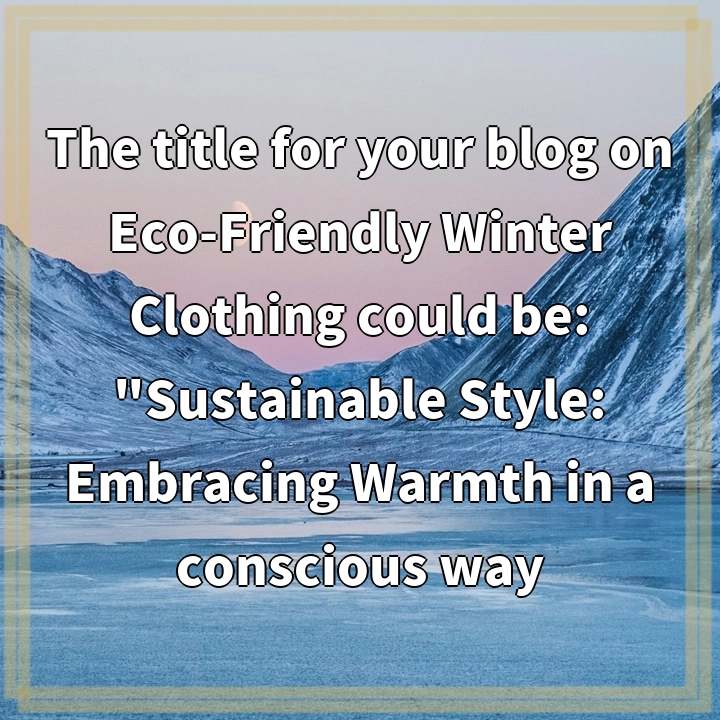
What is Sustainable Style: Embracing Warmth in a Conscious Way?
Sustainable style refers to the practice of choosing clothing and accessories that are eco-friendly, ethically produced, and have a minimal negative impact on the environment. In the context of winter clothing, it means opting for garments that keep us warm while also considering their environmental and social implications.
Real-World Problems Associated with Sustainable Winter Clothing
While sustainable winter clothing is a commendable choice, there are several challenges and problems associated with it that need to be addressed in order to create a more sustainable and ethical fashion industry.
1. Limited Availability and Accessibility
One of the main obstacles to sustainable winter clothing is the limited availability and accessibility of such products. While some sustainable fashion brands have emerged in recent years, they often have a relatively higher price point compared to fast-fashion alternatives, making them less accessible to the general population. Additionally, sustainable winter clothing options may be limited in terms of design and style, making it difficult for individuals to find products that align with their personal preferences.
2. Lack of Transparency and Greenwashing
Another challenge in the sustainable fashion industry is the lack of transparency in supply chains and production processes. Some companies may engage in greenwashing, which involves making misleading claims about the sustainability of their products without providing concrete evidence. This makes it difficult for consumers to differentiate between genuinely sustainable brands and those that are simply capitalizing on the growing demand for eco-friendly fashion.
3. Overcoming Seasonal Trends and Fast Fashion Culture
The fast fashion culture perpetuates the idea of constantly updating one’s wardrobe, following the latest seasonal trends. This leads to increased consumption and disposal of clothing, contributing to environmental degradation. Sustainable winter clothing challenges this culture by promoting the idea of investing in high-quality, durable garments that can withstand multiple seasons. However, changing consumer attitudes and behaviors remains a significant hurdle in achieving this shift towards a more sustainable fashion industry.
4. Synthetic Materials and Microplastic Pollution
Many winter garments, especially those designed for warmth, are made from synthetic materials such as polyester and nylon. These materials are derived from fossil fuels and have a negative environmental impact throughout their lifecycle. Additionally, when washed, synthetic materials release microplastic fibers into the water bodies, contributing to the growing problem of microplastic pollution.

Solutions for Sustainable Winter Clothing
Addressing the real-world problems associated with sustainable winter clothing requires a collective effort from various stakeholders, including consumers, brands, and policymakers. Here are some solutions that can help create a more sustainable and ethical fashion industry:
1. Increasing Accessibility and Affordability
Brands and retailers can work towards making sustainable winter clothing more accessible and affordable. This can be done by scaling up production, optimizing supply chains, and exploring innovative business models that prioritize sustainability without compromising on price. Collaboration with local artisans and communities can also help in incorporating traditional and sustainable practices into winter clothing production, promoting unique and accessible options for consumers.
2. Transparency and Certifications
Greater transparency regarding supply chains and production processes is essential. Brands can adopt certifications, such as the Global Organic Textile Standard (GOTS) or Fairtrade certification, to provide assurance to consumers that their winter garments are produced in an ethical and sustainable manner. Supporting initiatives like Fashion Revolution’s “Who Made My Clothes” can encourage brands to disclose information about their supply chain and promote transparency throughout the industry.
3. Educating Consumers
Consumer education plays a crucial role in promoting sustainable winter clothing. Brands can invest in educational campaigns to raise awareness about the environmental and social impact of fast fashion and the benefits of choosing sustainable alternatives. Sharing information about eco-friendly materials, responsible production practices, and the importance of extending the lifespan of winter garments can empower consumers to make conscious choices.
4. Embracing Circular Fashion
Transitioning towards a circular fashion economy can significantly reduce the environmental impact of winter clothing. Brands can innovate by implementing take-back programs, recycling initiatives, and designing garments that are easily repairable or upcyclable. Emphasizing the longevity and versatility of winter garments can encourage consumers to opt for timeless and durable pieces, reducing the need for constant replacements.
5. Supporting Sustainable Material Choices
Encouraging the use of sustainable materials, such as organic cotton, hemp, or recycled fibers, can help mitigate the environmental consequences of synthetic materials. Brands can partner with textile innovators to develop and invest in eco-friendly materials that maintain warmth without compromising on performance. Investing in research and development can lead to breakthroughs in sustainable textile options for winter clothing.















